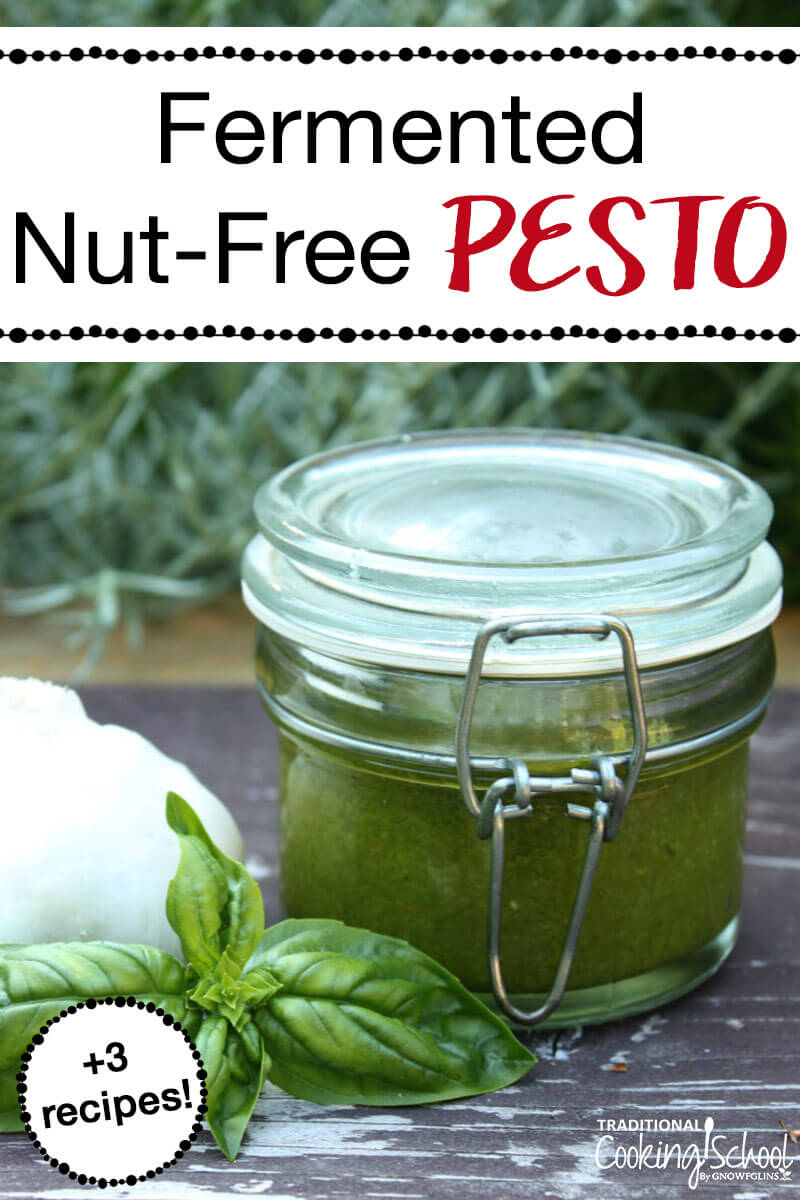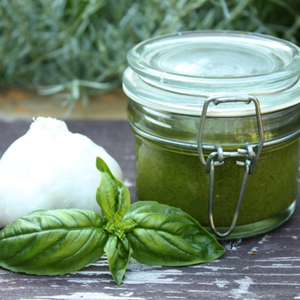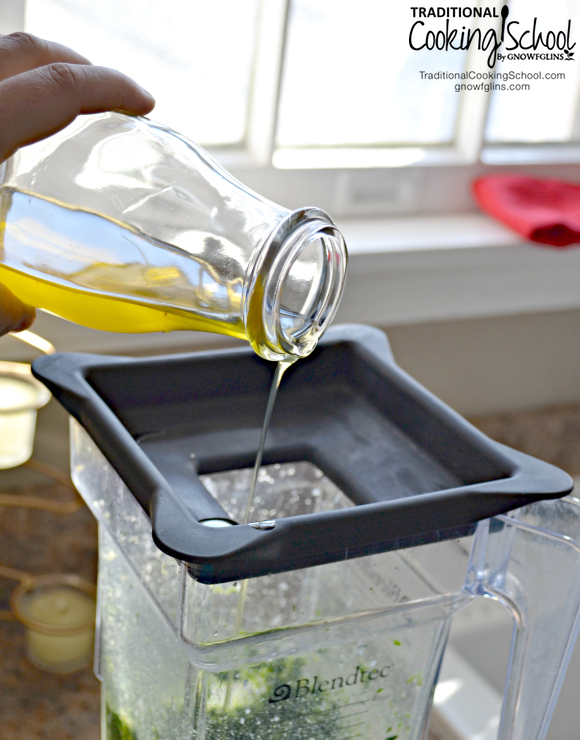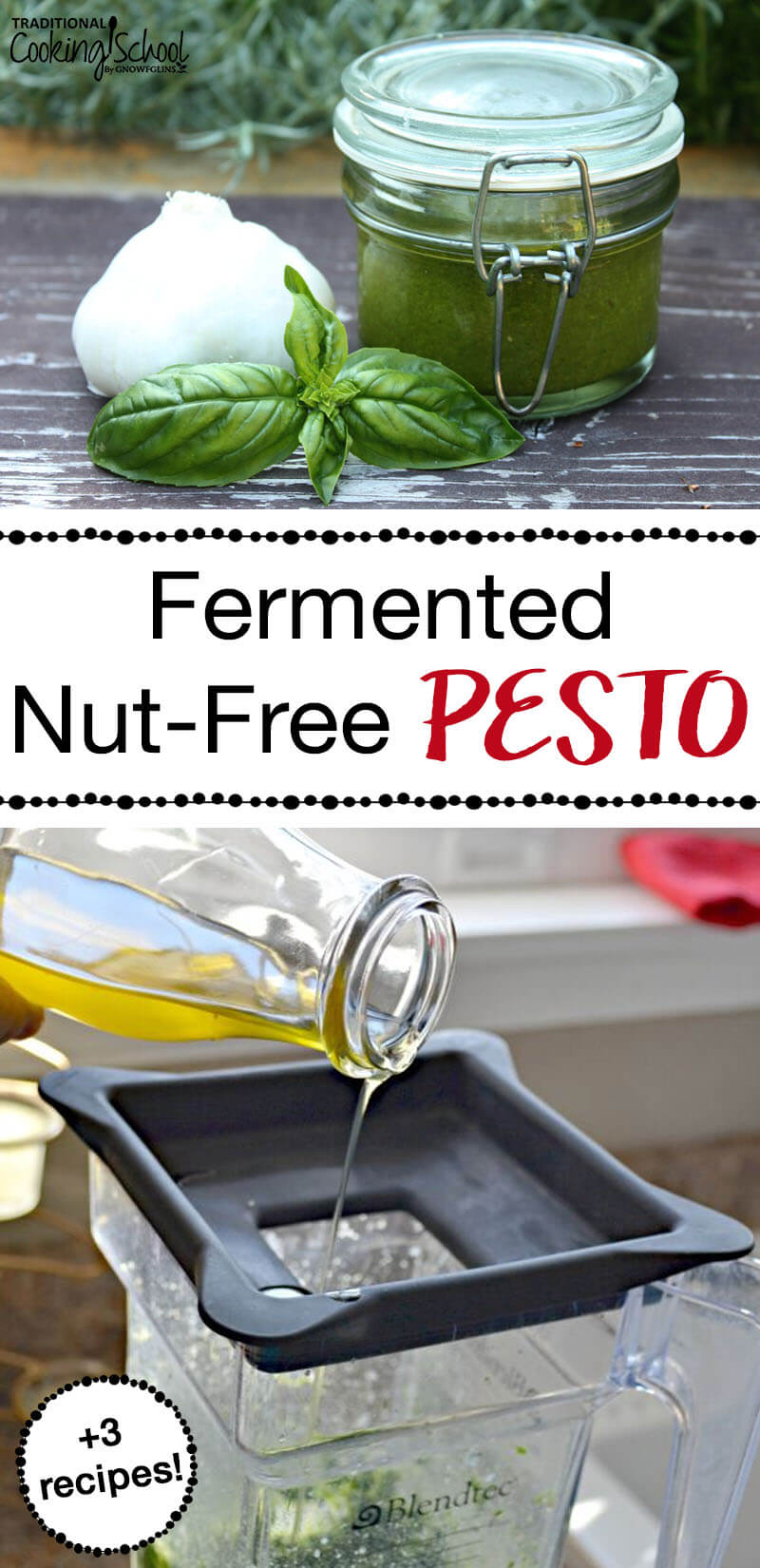Pesto, basil, garlic, cheese and oil, could there be a better combination? We think not! It’s simple to make, yet adds such complexity to hot or cold dishes. It has so few ingredients and takes so little time to make. In the case of this pesto, it’s nut-free and also packs a powerful probiotic punch and is our favorite topping for Sourdough Pesto Pizza.

Ahhhh, pesto.
Since nuts in general, and pine nuts in particular, are really expensive, I’ve adapted this pesto recipe to be nut-free. Not to mention, some folks can’t have nuts at all. No one should have to live a life without pesto! 😉
This recipe also packs a powerful probiotic punch — which means instead of spoiling quickly as pesto tends to do, it’ll last about 4 to 6 weeks in your fridge.
So if you find that basil is coming out your ears during peak gardening season, preserve your harvest with pesto! For more ideas, check out 5 Ways To Use Basil.
And for even more nut-free and allergy-friendly recipes, check out the Allergy-Free Cooking eCourse.

Fermented Nut-Free Pesto
Ingredients
- 2 cups basil leaves organic, packed
- 1 cup Parmesan cheese grated
- 3 cloves garlic
- 1/4 cup lemon juice approximately 1 lemon
- 1/2 cup extra virgin olive oil
- sea salt to taste
- pepper to taste
- 2 tablespoons liquid whey or veggie starter culture*
Instructions
-
Separate basil leaves from stem and wash them.
-
Pack all of the leaves into a measuring cup.
-
Add to a food processor or high-powered blender (I used my Blendtec).
-
Next, add cheese, garlic, lemon juice, salt, pepper, and whey.
-
With the blender on low, drizzle the olive oil in slowly.
-
You may need to scrape down the sides a couple of times until it really gets going.
-
Process until smooth and taste.
-
Add more salt, pepper, or any of the other ingredients, if necessary.
-
Transfer to a clean glass jar and close.
-
Leave on your counter or other warm place (out of direct sunlight) for 4 to 6 hours, then refrigerate.
Recipe Notes
*We like this veggie starter culture.

How To Use Pesto
It’s so easy! Boil water. Add pasta. Cook. Drain. Add pesto. Stir. Eat. Repeat if needed.
If you want to get a little fancier, however, here are a few ideas to get you started…
Grown-Up Grilled Cheese
Take 2 slices of sprouted or sourdough bread — the good, thick kind that stands up to being cooked in a skillet. Slather 1 side of each slice with salted butter. Then spread pesto on one or both of the other sides of each slice.
Place in a skillet and add sliced mozzarella, fontina, and gouda cheeses to the bread. Toast well on both sides, until cheese is melted.
Pesto Pasta Salad
Cook pasta, such as penne or elbow macaroni, according to package directions.
Drain and add a few tablespoons pesto, some sliced olives, sun-dried tomatoes, capers, feta or Parmesan cheese, sliced pepperoncinis, and cubed pepperoni, salami, or chicken. Refrigerate and serve cold.
Italian Quesadilla
Spread butter on one side of sprouted or sourdough tortillas. Spread pesto on the other side. Add mozzarella cheese and other fillings of choice, such as nitrate-free Italian sausage, pepperoni, or hard salami, sliced tomatoes, red onions, mushrooms, bell peppers… Get creative!
Cook in a medium-high skillet until tortillas are browned and cheese is melted. Cut into wedges and serve with hot, homemade marinara sauce for dipping.
Have you ever made lacto-fermented, nut-free pesto? What types of dishes do you love pesto with?

Free CHEAT SHEET: “Create Your Own Ferments” Fermenting Formulas
Want to create your own safe-to-eat and delicious fermented salsas, chutneys, pickles or krauts? Need to know how long to ferment, how much salt to add, and how to store?
This cheat sheet will give you formulas for all types of ferments (even fruit preserves, pickled meats, and condiments) – so you can “create your own” ferments with confidence.
This post was featured in 50 Fermented Salsas, Dips, and Spreads.
We only recommend products and services we wholeheartedly endorse. This post may contain special links through which we earn a small commission if you make a purchase (though your price is the same).



Lindsey, this looks delicious. I love that it is fermented and that it will keep longer. Could you add pine nuts to this and ferment it? Thanks.
Tia, you certainly could add pine nuts if you want to. Nothing about the fermentation will change, though. Enjoy!
I love this recipe! We really enjoy pesto but I frequently forget to have pine nuts on hand. I’m tickled to learn I can make it without.
I love pesto on a hamburger or chicken breast. I’ve even put it on grilled steaks toward the end of cooking.
Cindy, my favorite way is to slather a chicken breast with pesto and bake it in a glass dish. So, so yummy! I have this for lunch regularly.
Hi thanks for the recipe. My son loves pesto on homemade bread with parmesean and toasted in oven. We add tomatoes to ours. I was however wondering if the fermentation changes the flavor of the pesto? My son is super picky and has a great nose…lol
Thanks for your website, am enjoying it.
Christie, My family and I don’t notice any sort of fermented/sour flavor. I think the basil and garlic are such strong flavors that they mask the whey really well. In fact, my husband really does not like fermented foods, and he didn’t say anything about the pesto having a fermented flavor. Hope that helps!
I add pesto to my homemade minestrone soup. Adds so much flavor and deepens the complexity. Wonderful.
Brilliant way to add a fermented food where it wouldn’t be expected! I have to be off dairy right now, how do you think it would taste without the cheese? Not truly pesto-ey, I know, but still… might work out?
I would think 4-6 hours is honestly not enough time to establish lactofermentation as there are very distinct phases that occur even though a starter circumvents nature; not to mention the flora in whey, assuming you mean one should use a whey from mesophilic cultured dairy, really is not condusive to vegetable ferments. A bigger concern is botulism. Especially if one fails to get this below 38F promptly..oil is prime breeding ground for botulinum. I would ferment sans oil and just before refrigerating add the oil. But that is just me.
I was wandering if vinegar could be substituted for the lemon? Looking forward to trying this recipe!
How long will it keep in the fridge? Or will it keep indefinitely because of the whey in it?